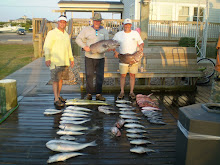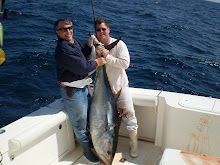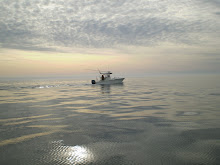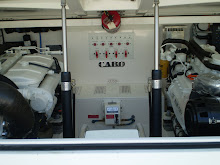 By Jim Field
By Jim FieldIn this Sunday's New York Times magazine, the Food Section featured an article about the need for restaurants and common citizens to focus on lesser-known fish, given the devastated populations of those fish we've all come to know and love--grouper, red snapper, haddock, cod, et al--and eat voraciously, until there's none left in the sea.
The article introduced Mark Marhefka, a commercial fisherman (see photo) who started a company, Abundant Seafood, to harvest this next "tier" of lesser known fish, which, being lesser known, are thus more "abundant"--at least for the time being! (Also look at the topside of his vessel: pure 100% unpainted fiberglass resin.)
To quote from the article:
"'This whole next couple years is gonna be weird,'" Marhefka said between bites of triggerfish. His dish was notable, and not just because he caught it. Until recently, such "trash fish" wouldn't be served in fine resturants. But Marhefka has introduced chefs to more sustainable species."
It was also noted that restaurants are sometimes willing to pay 25 to 55 cents more per pound for his pole-caught fish.
For every fisherman's information, the article also went on to restate important new regulations that took effect Jaunary 1: commercial and recreational fishing for most species of shallow-water grouper, as well as black sea bass, red porgy and red snapper, is closed in North Carolina, South Carolina, eastern Florida and Georgia for 4-6 months, after which strict catch limits will be imposed.
(Note to The Crew: we will need to understand how they defined "shallow water").
Finally, the article included this interesting passage:
"Reached by phone eight days after the fishery closure, Marhefka was figuring out what to do with 1,200 pounds of vermillion snapper--one of the few permitted fish besides triggerfish, king mackerel, and amberjack."
Being a Food Section piece, a recipe was attached, which I've reproduced below.
May God protect these newly-targeted fish from the wrath of commerical fishermen!

The Recipe (sounds good, if a bit complex)
4 cups water
1 large carrot, peeled and chopped
1/2 medium onion, peeled and chopped
1 small shallot, peeled and chopped
1 leek, cleaned and chopped
1/4 medium fennel bulb,whole with fronds
1 fresh bay leaf
1/2 bunch fresh parsley
2 teaspoons sugar, plus more to taste
2 small garlic cloves,peeled
1/4 cup white wine
Various seasonal market vegetables
2 bunches basil, leaves removed
1 clove garlic, peeled and chopped
Salt and freshly ground pepper
4 tablespoons olive oil
4 triggerfish fillets (see note)
Cayenne pepper
Canola oil
Juice of 1 lemon
Various seasonal herbs, greens and edible flowers,(flowers optional).
1. Combine the first 11 ingredients in a large pot. Simmer for 25 minutes. If using right away, strain and move on to Step 2. Otherwise, the broth can be cooled and stored, unstrained, in the refrigerator for up to 1 week.
2. Preheat the oven to 300 degrees. Wash the vegetables and peel, if necessary. They can be prepared in any or all of the following ways: cooked in the broth until tender and left whole; cooked in the broth until tender and then puréed with broth; or left raw and shaved with a mandoline or peeler. Utilizing all three of these methods makes for a beautiful presentation.
3. Bring a medium pot of salted water to a boil. Have a bowl of ice water ready. Blanch the basil for 2 seconds. Quickly remove and immerse in the ice water. Strain and put in a blender with the garlic clove, salt, pepper and sugar to taste; add plenty of broth to keep the purée spinning. When it’s smooth, slowly drizzle in 2 tablespoons of the olive oil to emulsify. Strain, reserving the bright green broth. Discard the solids.
4. Season the fish fillets with salt and cayenne. Heat a large sauté pan over high heat. Add enough canola oil to cover the bottom. When the oil shimmers, add 2 fillets to the pan, skin side up, and do not disturb. Cook until golden brown, 3 to 5 minutes. Place on a baking sheet, skin side down. Repeat with the remaining 2 fillets. When all the fillets are seared on one side, drizzle with 2 tablespoons olive oil and a little lemon juice. Place the baking sheet in the oven and cook until the fish is opaque throughout, 6 to 8 minutes.
5. Ladle the pistou into 4 warm bowls. Divide the vegetables among them, reserving some of the shaved ones. Place the warm fish on top of the vegetables. Garnish with herbs, greens, edible flowers (if desired) and remaining shaved vegetables. Serves 4. Adapted from Sean Brock at McCrady’s in Charleston, S.C.
NOTE: Any firm, fresh, locally caught whitefish may be used.









No comments:
Post a Comment